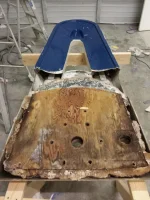Hmmmm...was going to let this pass. But now that I am being attacked on two fronts feel I best muster a response. My thread was simply a suggestion in the event no one had previously considered it. (Full disclosure, I have not tried this nor have experience with the applicatiation.) However, I will refer you to the information posted on the West Marine site that says the material "will" cut, drill, shape and rout using standard woodworking tools.
http://www.westmarine.com/buy/west-marine--marine-lumber-plastic-building-material--P004_135_001_009 If your point is that it will not drill or cut like wood, you got me there. Obviously, it is not wood. Additionally, yes, I understand that it will not adhere with adhesives such as epoxies. However, it will adhere with wood screws to the top of the deck (which is the way the plywood was originally fastened down) and seal with Dow 795 (silicon). As for it's tolerance to heat, I have no experience, but I do not intend to flame or blow torch it. Inside the bow pulpit I do not expect temperatures to rise to the point where the stuff melts, but I could be wrong.
It is my understanding that the only purpose of the plywood piece between the deck and bow pulpit is to stabilize and prevent horizontal torqueing of the bow pulpit. If so, then Starboard once sealed, fastened and secured should serve the same purpose. In fact, I'm not even sure the original design with plywood really matters or was sound from the start. There are six stout bolts holding down the pulpit. I doubt that the plywood adds much additional structural integrity...expecially after it has become rot. And therein lies the primary difference. Starboard (or for that matter any other HDPE or polycarbonate) provides equal structure with out the risk of being compromised by water or rot.


